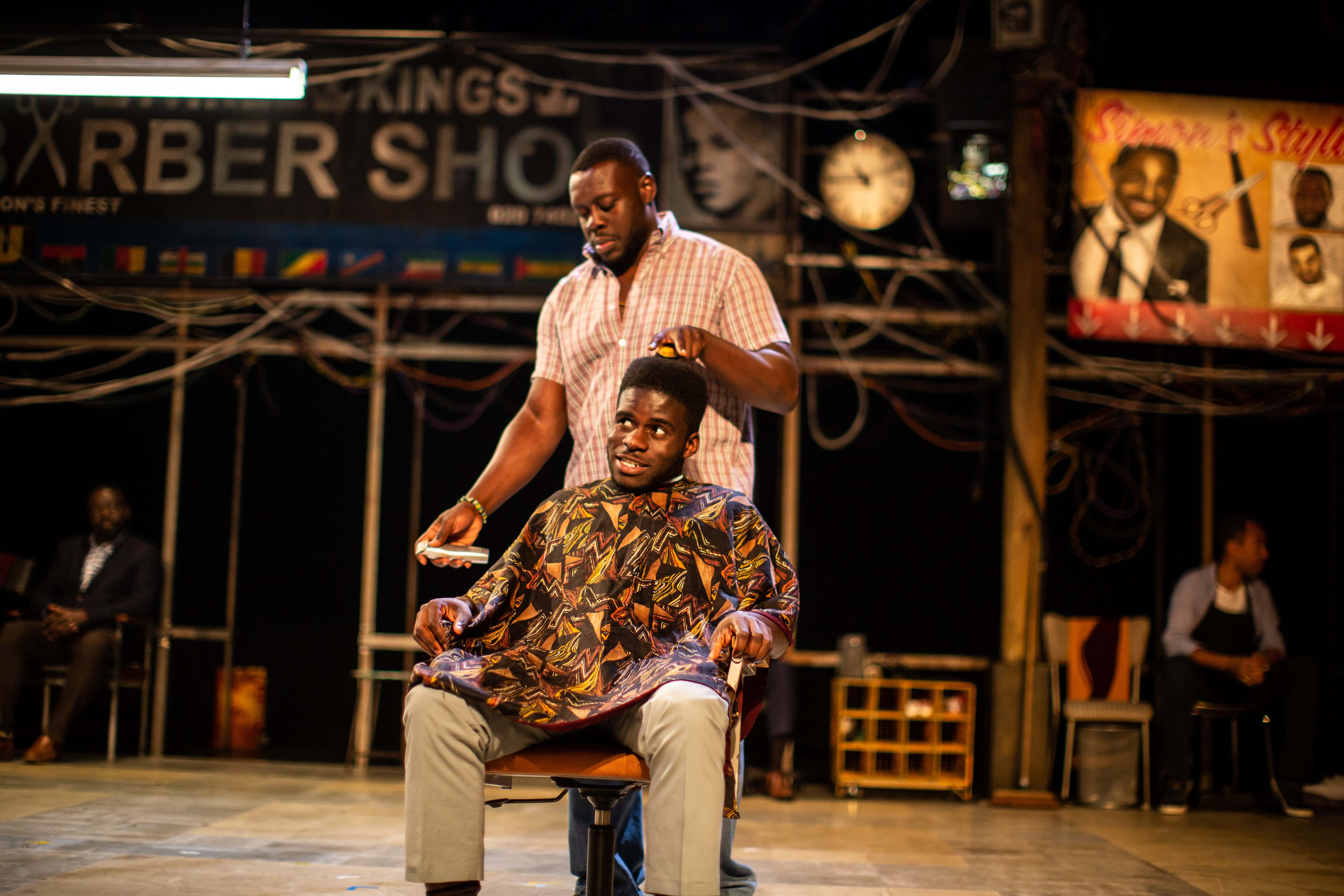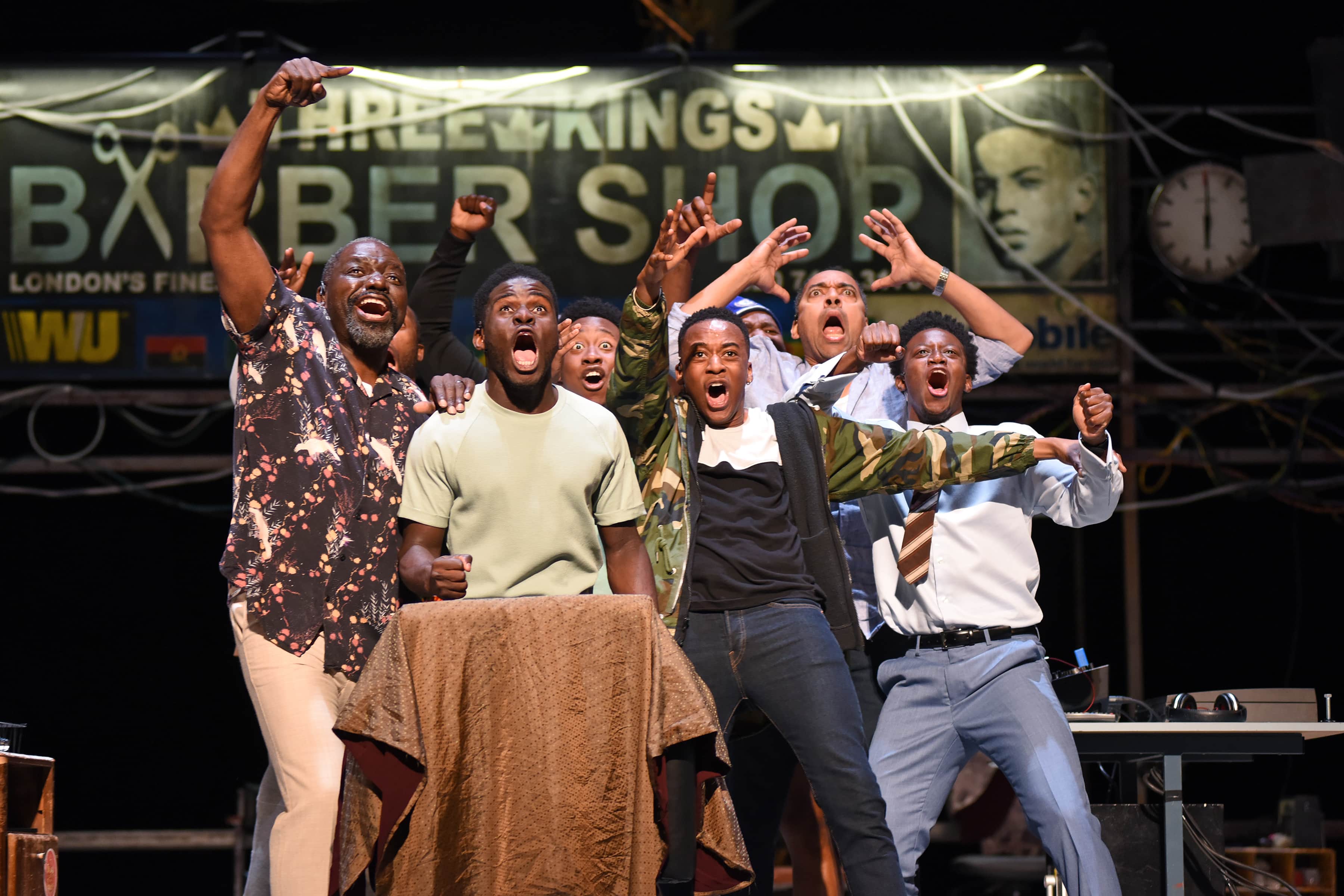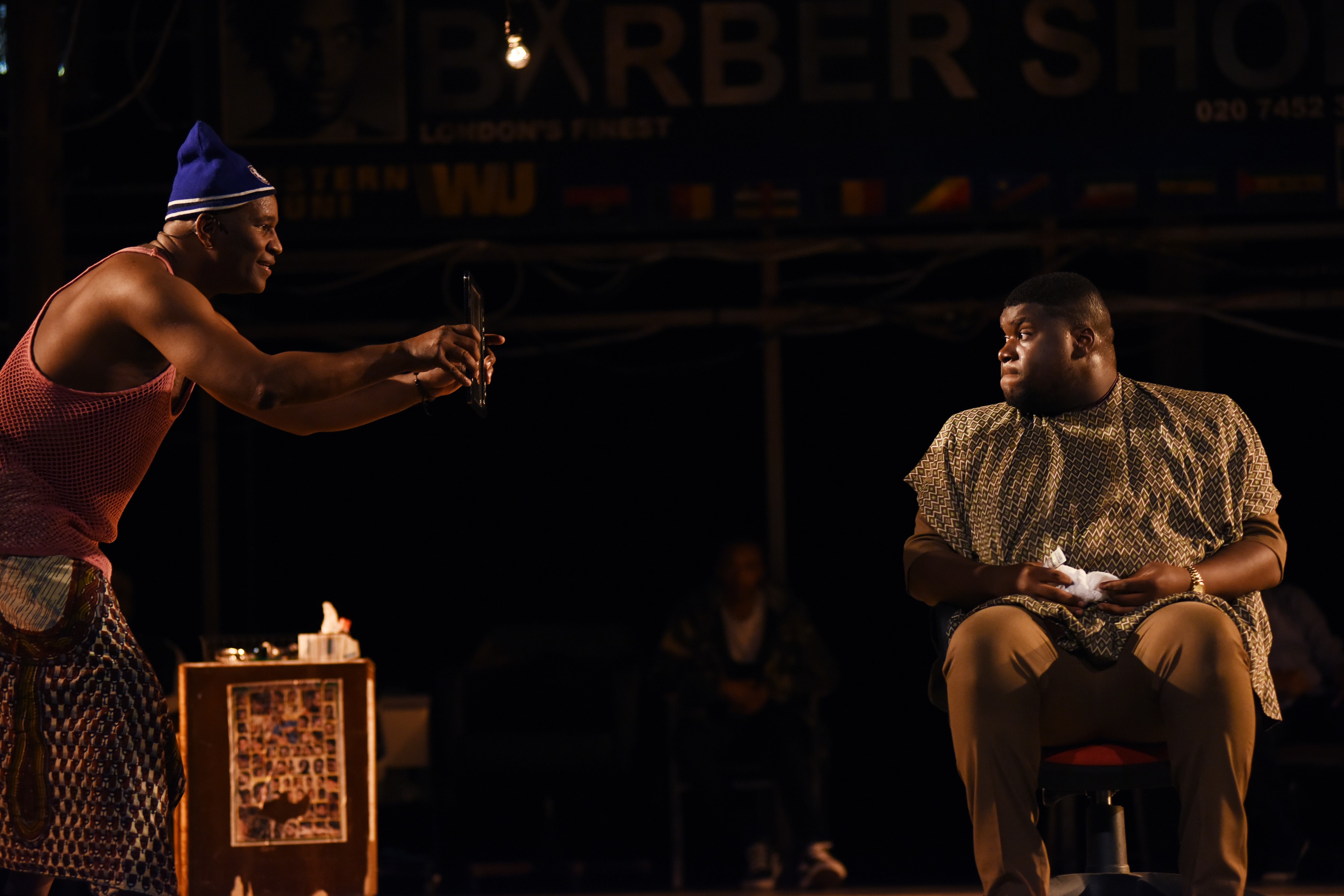“To let one’s hair down” is to open up, be freer than usual, be willing to share. The idiom is apt for what transpires in Barber Shop Chronicles, an extraordinary exploration of black masculinity, in all its vulnerability and dignity. As entertaining as it is profound, the show was a sold-out, critically acclaimed hit in London, and it just arrived at Kennedy Center for a brief stop on its U.S. tour.
Barber Shop Chronicles, a play with music and movement, bursts upon the Eisenhower Stage like a festival of honesty and virtuosity. Fascinating vignettes set in barber shops in London and five towns in Africa (Johannesburg, Harare, Kampala, Lagos, Accra) alternate with transitional passages of breathtakingly beautiful choreography and choral singing.

The brilliant Nigeria-born playwright Inua Ellams took a tape recorder with him on visits to actual barber shops and listened in on men’s candid banter there. With his poet’s gifts of concision, he then chiseled what he heard into taut, interweaving episodes about fatherhood and sonship, raising children, intergenerational relations, life under colonializing governments, and more.
Ellams has called black men’s barber shops a sacred place. In the play they’re referred to as the black man’s pub. In performance in Barber Shop Chronicles they vividly become safe supportive communities, small separate worlds, that are tethered to one another by the shared struggles and aspirations of African men in their homeland and the diaspora.
The design by Rae Smith makes that metaphor material. Directly above centerstage is a huge wireframe globe that twirls and lights up to indicate which country we’re in. Hanging everywhere are colorful sideshow-like painted panels illustrating popular haircuts, ballyhooing the show’s locales (“Lagos’ Finest,” “Tinache’s Trims,” “Simon’s Stylings”), and lit up to indicate which barber shop we’re in. Suspended all about are swooping fiber ropes that illuminate like glowing tendrils interconnecting everything.
There’s a fun preshow. The cast dances impromptu to lively music tracks. Audience members might sit in the onstage barber chairs and get a simulated haircut. The exuberant energy is infectious, and it is sustained throughout under Bijan Sheibani’s impecable direction, through scenes of laughs and emotion.

The play takes place in many places but on a single day, with the passing time indicated by a pair of clocks. It’s the day of a big televised soccer match that grips the attention of the entire ensemble, who cheer and roar with approval when their team scores. This establishes the baseline sportsfan bond among these men—but the play is about to go deeper, more personal, more interrelational, more truthful.
The first scene is a simple one. A young man has an emergency. He needs a haircut for a job interview he’s about to have. So he wakes up the local barber three hours before the shop is supposed to open. The young man gets his haircut but can’t afford the price, so he hightails out without paying. What we don’t know yet is that each of these characters will reappear in the narrative—just as characters and themes in subsequent scenes will interweave in a richly rewarding tapestry of tales.

Along the way are markers of what I take to be the playwright’s point of view on black masculinity.
1. It is proud of being black. At one point there is a funny debate referencing Tupac about whether the n-word spelled -igga is better than -igger, the unequivocal conclusion of which is: “Shit in anything still smells like shit.”
2. It is not homophobic. At one point there is a judgmental reference to how Uganda treats gays that comes in the context of a matter-of-fact and nonplussed reference to two African men (not characters in the play) who are a couple. It goes by fast, but it signals something lasting about how all the characters are portrayed.
3. It is not misogynist. With only men in a cast of characters and no women characters to speak on their own behalf, we must rely on how the male characters talk about women to know whether a play’s intent is counterpatriarchal or not. And in this regard Ellams leaves some telling cues. For example, there is an exchange between an older and a younger man having to do with the older man’s persistence in trying to get a woman to have sex with him. “I am wearing her down little by little,” the older man boasts. “Women don’t wear down, they get tougher,” says the younger man, “even I know that.”
4. It is adamant about justice. Near the end there is a scorching, show-stopping monolog by character who is enraged at Mandella’s embrace of Truth and Reconciliation in post-apartheid South Africa. The character cannot abide the fact that the white apartheid government got off the hook for what it did.
In a talkback after opening night, the playwright said he wrote Barber Shop Chronicles to offer “a glimpse into a world otherwise not seen.” Some further remarks fleshed out his point of view on masculinity, both autobiographially and politically. In Africa, he said, he was seen as man; not until until he came to London was he regarded as a black man. He has a twin sister. Just as he and his sister were equals in the womb, he grew up believing women equals in the world. And as a poet reading his poems to live audiences, he realized he was being applauded for being vulnerable. In Barber Shop Chronicles he wanted to create a safe space where other men could know that experience too.
In theatricality and topicality, Barber Shop Chronicles is a triumph.
Credits:
By Inua Ellams
Directed by Bijan Sheibani
Designed by Rae Smith
Lighting Designer: Jack Knowles
Movement Director: Aline David
Sound Designer: Gareth Fry
Music Director: Michael Henry
Fight Director: Kev McCurdy
Associate Director: Stella Odunlami
Associate Director: Leian John-Baptiste
Assistant Director: Kwami Odoom
Wallace / Timothy / Mohammed / Tinashe: Tuwaine Barrett
Tanaka / Fiifi: Mohammed Mansaray
Musa / Andile / Mensah: Maynard Eziashi
Ethan: Alhaji Fofana
Samuel: Elliot Edussah
Winston / Shoni: Solomon Israel
Tokunbo / Paul / Simphiwe: Patrice Naiambana
Emmanuel: Anthony Ofoegbu
Kwame / Fabrice / Brian: Kenneth Omole
Olawale / Wole / Kwabena / Simon: Ekow Quartey
Elnathan / Benjamin / Dwain: Jo Servi
Abram / Ohene / Sizwe: David Webber
Running Time: About one hour 50 minutes, with no intermission.
Barber Shop Chronicles plays only through December 1, 2018, at the Kennedy Center’s Eisenhower Theater – 2700 F Street, NW, in Washington, DC. For tickets call 202-467-4600 or go online.
The National Theater Production of Barber Shop Chronicles is presented in collaboration with the Laboratory of Global Performance and Politics and LabPerform, a series of public workshops and discussions. Playwright Caleen Sinette Jennings moderates a discussion with Playwright Inua Ellams Friday morning, November 30, at Georgetown. For more information, click here.




